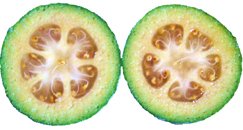Selection and storage
Feijoa season varies depending on the location. In Brazil, they appear in markets from late March to July. In New Zealand, you can find them from March to June, although they’re often available in supermarkets for longer.
When shopping, seek out fresh arrivals. Opt for dark green, ellipsoid-shaped fruits with a distinct fruity scent. Check for any signs of damage like bruises, cuts, or blemishes and avoid those. A ripe feijoa will yield slightly to gentle thumb pressure.
Once ripe, feijoas don’t last long at room temperature, usually no more than two days. If not eaten promptly, store them in the refrigerator for up to 1-2 days. Alternatively, they can be kept in the freezer for a couple of months.
Preparation and serving methods
 |
| Feijoa fruit cut section. Courtesy: Pingked |
To prepare feijoa, start by selecting fresh, ripe fruit. Gently rinse and pat dry. Cut the fruit in half with a paring knife, then scoop out the juicy pulp using a spoon, similar to how you would with sapodilla. The flesh has a sweet-sour taste and a sandy texture, while the skin, although edible, is usually discarded.
Here are some serving ideas:
- Enjoy the fruit as is to savor its natural flavor.
- Juice it for a delicious drink.
- Add aromatic slices to salads.
- Incorporate it into baked goods like muffins and cakes.
- Use it to make purees, jellies, jams, chutneys, juices, sorbets, and more.
Safety Profile
Feijoa fruit consumption is considered safe for human health, including for pregnant mothers and infants.
medical disclaimer for more information).
≻≻-Back to Fruits from Feijoa. Visit here for an impressive list of all varieties of fruits with complete illustrations of
their nutrition facts and health benefits.
≻≻-Back to Home page.
Further reading and Resources:
-
Stanford School of Medicine Cancer information Page- Nutrition to Reduce Cancer Risk.

